

THE TEMPLE NEWS
A watchdog for the Temple University community since 1921.
Sidney Rochnik Editor-in-Chief
Valeria Uribe Managing Editor
Anna Augustine Managing Editor
Ryan Mack Co-Chief Copy Editor
Bradley McEntee Co-Chief Copy Editor
Nathan Horwitz Co-News Editor
Connor Pugh Co-News Editor
Clarissa Jett Assistant News Editor
Caelan O’Neill Opinion Editor
Wania Irfan Assistant Opinion Editor
Madelynne Ferro Features Editor
Benjamin Dipalma Assistant Features Editor
Sienna Conaghan Co-Sports Editor
Colin Schofield Co-Sports Editor
Jacob Moreno Assistant Sports Editor
Leah Duffy Investigative Reporter
Tellicia Walker Investigative Reporter
Julia Anderson Director of Audience Engagement
Nathaniel Thrush Co-Community Engagement Coordinator
Kayla McMonagle Co-Community Engagement Coordinator
Isabella Farrow Audience Engagement Editor
Nalani Chiles Audience Engagement Editor
Xavier Johnson Sports Engagement Editor
Brian Nelson Photo Editor
Lillian Prieto Assistant Photo Editor
Aidan Gallo Assistant Photo Editor
Ava Campbell Multimedia Editor
Jeremy Shover Assistant Multimedia Editor
Jack Larson Print Design Editor
Daniya Eggleston Graphic Design Editor
Chili Ramgolam Data Editor
Ariana Droz Podcast Editor
Sage Spohn Newsletter Editor
Nadia Bodnari Web Editor
Maria Lombana Advertising Manager
Aaliyah Abdur-Rashid Advertising Manager
Calista Aguinaldo Business Manager
The Temple News is an editorially independent weekly publication serving the Temple University community.
Unsigned editorial content represents the opinion of The Temple News.
Adjacent commentary is reflective of their authors, not The Temple News.
The Editorial Board is made up of The Temple News’ Editor-inChief, Managing Editors, Chief Copy Editor, Deputy Copy Editor, News Editor and Opinion Editors. The views expressed in editorials only reflect those of the Board, and not of the entire Temple News staff.
CORRECTIONS
ON THE COVER DEMERICK MORRIS MADE THE GAME-SEALING SACK ON SATURDAY.
Contacts
Visit us online at temple-news.com
Email section staff news@temple-news.com letters@temple-news.com features@temple-news.com sports@temple-news.com
The Temple News is located at: Student Center, Room 243 1755 N. 13th St. Philadelphia, PA 19122
In the print issue on Sept. 23, an article on an alumna’s play did not credit the work of Danica Godshall in writing and reporting for this story.
In a column about alcohol boundaries, tbe Temple Collegiate Recovery is incorrectly stated to meet weekly when they meet monthly.
Accuracy is our business, so when a mistake is made, we’ll correct it as soon as possible. Anyone with inquiries about content in this newspaper can contact Editor-in-Chief Sidney Rochnik at editor@temple-news.com.
JACK MACY / THE TEMPLE NEWS
NEWS
ADMINISTRATION
Temple introduces new academic advising app
Navigate360 allows students to schedule academic advising appointments and more.
BY CONNOR PUGH Co-News Editor
Temple launched Navigate360, a platform for academic advising, scheduling and other campus resources Sept. 26, Vice President for Enrollment and Student Success Jose Aviles wrote in an announcement to the Temple community.
Navigate360’s services were previously conducted through the Student Tools tab on TUportal. As of Sept. 26, all academic advising services have transitioned from the TUportal to the new app.
“It’s more than just advising or an app,” said Shawn Fagan, assistant vice provost for student success. “It’s a student success platform.”
Navigate360 was developed through a collaboration with EAB, a consulting firm that works to provide education solutions to its six major areas: enrollment, student success, data and analytics, institutional strategy, access and equity and advancement. Navigate360 is a customizable program developed by EAB and used by more than 850 two and four-year institutions across the country.
At Temple, the app lets students see their class schedules and campus resources like academic support locations and on-campus dining options.
Specific departments at Temple, like the College of Engineering, have previously used EAB products and services for advising and support.
Moira Kirby, assistant director for educational programming at the Student Success Center, is looking forward to how the app will support Temple students and improve their experience.
“I think it’s going to give students access to a tool that will help them schedule their appointments, something they’re familiar using from their other interactions with different departments,” Kirby said.
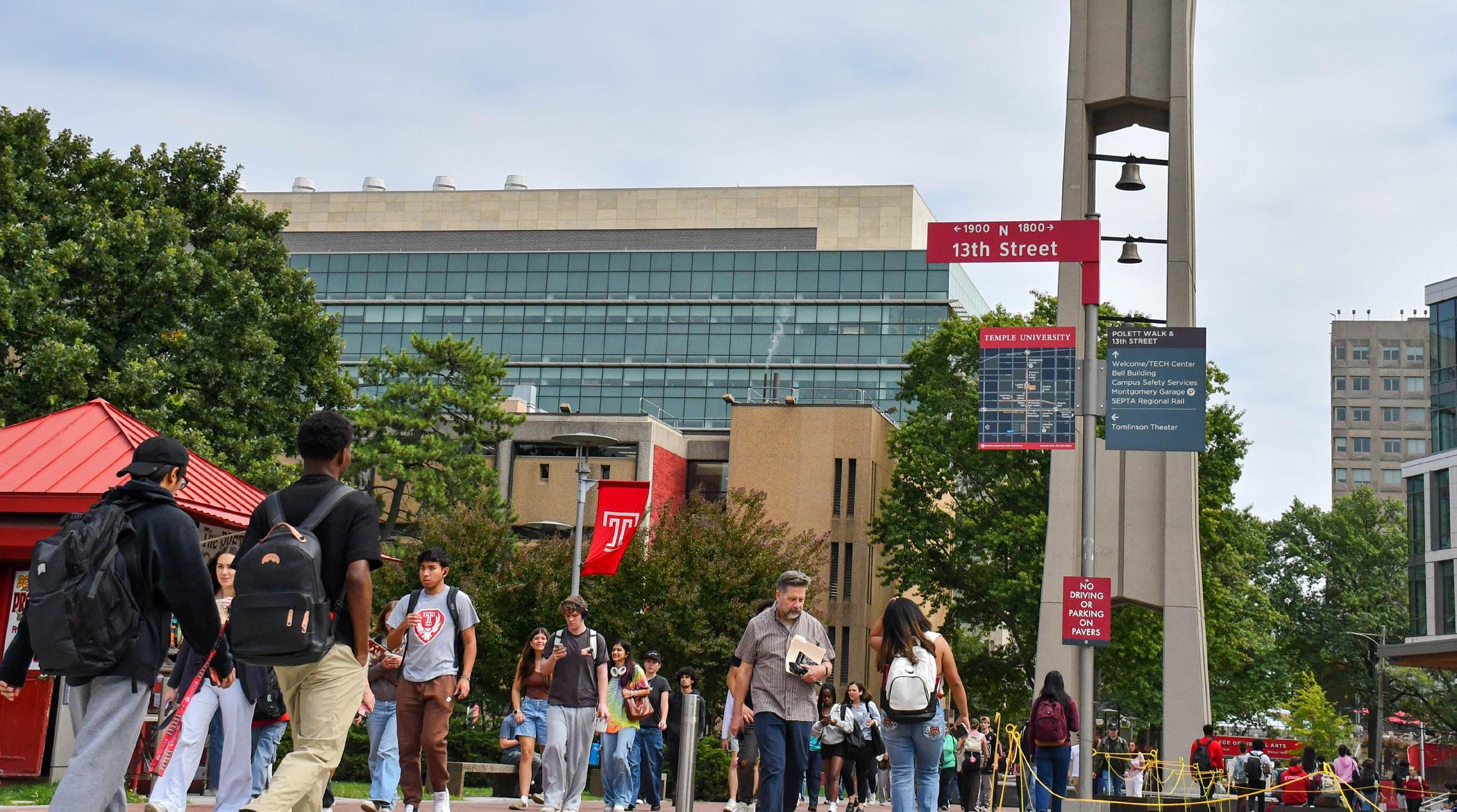
The SSC supports undergraduate and graduate students through tutoring and a Peer Assisted Study Session program and is looking for ways to further integrate Navigate360 with the center’s services, Kirby said.
The app will eventually incorporate resources from departments other than the SSC, including Student Affairs and the as-of-yet unopened Essential Needs Hub, but different Temple colleges and departments are still planning how to integrate more into Navigate360, Fagan said.
Navigate360 will also allow students to schedule sessions with “Study Buddies,” share notes and create study groups with other students in their courses.
Temple uses a variety of apps and programs to administer university services beyond the central TUportal. Students have to navigate to external sites or register for new accounts to schedule appointments with disability services, Temple Health or access the Cherry and
White Directory.
The TUportal provides links to its external services under the TUapplications tab. The tab also contains links to the Temple Canvas page, Adobe Creative Cloud and other academic tools not located within the TUportal.
Navigate360 now functions similarly, offering links and locations to resources like Temple Health, Tuttleman Counseling Services and Bursar’s Office.
Kennedy Nix believes that containing advising resources to a specific app has both pros and cons.
“I think it can also be confusing and make it a little bit harder, since it’s separate from like all the other resources,” said Nix, a freshman marketing major.
Moving academic advising to an external app allows for cross-platform collaboration among Temple departments, Fagan said.
Through an integrated Navigate360 network, different departments can send alerts to each other regarding the specif-
ic needs of a student and make sure they get the help needed across campus.
“If you think about Temple’s current system, not every school or college uses it, and it’s also a homegrown system,” Fagan said.
The incorporation of academic advising across multiple schools into one program will improve system efficiency and help students who may want to switch majors, Fagan said.
Fagan believes that the Navigate360 app and its features will ensure greater student success at Temple.
“I just think it’s a great step forward in terms of ensuring that students, once they get here to the time they graduate, that they’re supported in whatever way they need to be, and that could change over time,” Fagan said.
connor.pugh@temple.edu
LILLIAN PRIETO / THE TEMPLE NEWS Students on Polett Walk.
CAMPUS
Tyler glass program to add sustainable furnace
Tyler is using a $100,000 grant to replace a natural gas-powered furnace.
BY MAHDIA ARSHAD For The Temple News
The Tyler School of Art and Architecture will replace one of its three gas furnaces with a clean energy, electric furnace by January 2026, with funds from a $100,000 Frankenthaler Climate Initiative grant.
The replacement effort is spearheaded by Tyler’s glass department, which relies on the furnaces.
The Frankenthaler Climate Initiative, established in 2021 by the Helen Frankenthaler Foundation, partners with nonprofits Environment & Culture Partners and the Rocky Mountain Institute. The organizations are dedicated to improving and strengthening climate resilience across cultural and energy-related sectors.
The initiative is focused on introducing “transformative climate solutions” and has efforts across 300 museums and dispersed more than $17.5 million to various projects across 40 states.
The new furnaces are a step toward the university’s sustainability efforts, as the previous ones run on natural gas.
The carbon impact associated with these furnaces has the potential to alter climate, and the energy needed to run the furnaces can be replicated with fossil-free, renewable resources, like wind, solar and hydrogen, said Rebecca Collins, director of sustainability.
Natural gases are a major influence on climate change due to both their overuse and extreme impacts. Methane, the main component of natural gases, is often leaked into the atmosphere through fuel in industrial pipelines, ovens, heaters and cars. Methane has contributed to approximately 20 to 30% of global warming since the Industrial Revolution, according to NASA.

Glassblowing is very carbon-intensive because of the silica and amount of fuel used to melt, cool and form glass with the machinery, said Andrew Mahaffie, studio technician for Tyler’s glass hot-shop.
Changing the energy source and using modern production methods should help the furnaces run more efficiently.
“It uses less fuel, takes less power to keep on than the older equipment,” Mahaffie said. “That’s just a function of the refractory material they’re constructing these furnaces out of, the way they’re built, how many layers of insulation are in there, all the little mechanical things that add up to an efficient piece of equipment.”
The school estimates this first furnace will reduce its total emissions by 23.9%, according to Tyler social media. The glass program will compile data on the electric furnace and use it to do a comparative study on the differences between gas and electric that can inform sustainability efforts at other universi-
ties.
Alongside the conversion of energy sources, the grant provided by FCI will also help build an electrical grid to support this furnace and allow the future development of the two other furnaces.
The program’s sustainable progress has been in the works for several years.
Jessica Jane Julius, professor and head of the glass department, began a climate initiative program in 2019, amid the 50year anniversary of the department.
Tyler applied for the $25,000 scoping grant from the FCI, which the program received in 2024. These funds allowed the glass program to research and collect data on how they could implement sustainable practices.
The grant’s objective is to help institutions understand their energy needs and sustainable alternatives, according to the FCI.
“We did a lot of research,” Julius said. “We did a comparative study of academic programs across the United States and some international.”
Julius wants to leave a “lineage” for the glass department — and found one in sustainable conversion. The new furnace will save money and help conserve materials, while furthering students’ understanding of the materials they use, she said.
This initiative previously started a campaign involving not throwing away any glass created and “recycling” pieces into other artwork.
“I’m excited for [the glass program]. I’m excited for their journey. I’m excited for the future, to see what else they can come up with,” Collins said. “They did this independent of the Office of Sustainability. They found the grant, and they proposed it. They knew their space better than anybody else, and they took the initiative to say, ‘This is our responsibility.’”
Nathan Horwitz contributed reporting.
mahdia.arshad@temple.edu
AIDAN GALLO / THE TEMPLE NEWS Davis Thal blows a torch onto molten glass at the glassblowing studio at Tyler on Sept. 12.
RESEARCH
Temple team builds AI-powered mentorship app
JournAI aims to support student-athletes through a virtual guidance application.
BY NATHAN HORWITZ Co-News Editor
A Temple research team is growing an artificial intelligence-powered mentorship app focused on student-athlete development, after receiving an award from the National Collegiate Athletics Association.
The app, called JournAI, connects student athletes with “Sam,” a virtual mentor chatbot meant to interact with users about their careers and financial and mental wellness.
The School of Sport, Tourism, and Hospitality Management researchers hope to launch the app for student-athletes in Spring 2027, but they aim to eventually extend the resource to all Temple students.
Temple is one of three schools being awarded the grant out of a pool of more than 100 applications. The grant program supports data-focused test projects intended to improve the psychosocial and mental well-being of student-athletes. Temple will share $100,000 with Bowling Green State University and Emory State University for the next two years.
“This is huge for us,” said Elizabeth Taylor, project director of JournAI. “There aren’t a lot of opportunities for funding sports management research.”
JournAI’s research team conducted a 40-person pilot study last spring. STHM’s group then analyzed and presented that data at an academic conference, eventually earning them the grant.
The research team hopes to make the app a supplemental tool to work alongside existing resources for student-athletes, like career and financial counseling and mental health support.
JournAI uses a large language mod-

el which pulls from existing models like OpenAI, Anthropic and Groq to process written prompts and generate human-like responses based on its storage of past data. This program’s memory architecture allows Sam to recall longterm user data, wrote Robin Goetz, JournAI’s co-founder and lead developer, in an email to The Temple News.
At the beginning of a student interaction, Sam asks the athlete a series of questions. Their answers prompt a series of follow up inquiries to address their unique situation, whether it’s celebrating a win or figuring out what type of career they want to pursue post-graduation. Student-athletes can also talk to Sam unprompted to share about what’s happening in their lives, on or off the field.
“It picks up on your personal characteristics and your experiences and perceptions really fast,” Taylor said.
Developers hope Sam will be more accessible to busy athletes who may not
have time or access to human support.
“The schedule is super demanding,” said Taylor Davenport, an assistant coach for Temple Women’s Volleyball and co-developer of JournAI.
Division I athletes spend approximately 68.5 hours per week on their athletic and academic responsibilities, according to the NCAA.
Sam is intended to help users better understand themselves and their future goals and could serve as a precursor to meeting with an actual advisor, like a therapist or career counselor.
Philip Dames, director of the Temple Robotics and Artificial Intelligence Lab believes there are benefits to working through one’s thoughts with AI because of the lack of existing personal connection.
“It can be hard to say to a friend, ‘You’re not making sense right now,’” Dames said. [People] want to be supportive and not alienate them by pushing back. An AI system sometimes can make
it easier to be fully open and honest.”
The JournAI research team will spend the rest of the year developing the app and building out conversations. They will start to recruit participants in late December and early January, who will then engage in six to ten weeks of conversation with Sam during the Spring semester.
Davenport values JournAI’s ability to integrate support into student-athletes’ busy schedules. JournAI’s ability to validate user feelings while still providing constructive feedback was impactful in her experience, Davenport said.
“One of the best things about Sam is that they’re an unbiased friend,” Taylor said. “So, they’re not going to judge you for the things that you say. They’re empathetic.”
nathan.horwitz@temple.edu
BRIAN NELSON / THE TEMPLE NEWS Graduate assistant coach Taylor Davenport poses for a portrait with JournAI’s app.
FAFSA opens a week early with updated process
POLITICS The 2026-27 form launched on Sept. 24 with significant changes to the form.
BY NATHAN HORWITZ Co-News Editor
The Free Application for Federal Student Aid for 2026-27 opened on Sept. 24, the earliest release in the program’s history. The new form changed the account verification process and the process of inviting contributors to fill out their section of the form.
Students must complete the FAFSA form, which typically opens Oct. 1, to be eligible for federal grants, loans and work-study. Pennsylvania residents cannot receive the PA State Grant without submitting the FAFSA.
The improvements come after recent years’ FAFSA forms were bogged down in technical delays and difficult forms. Hundreds of universities, including Temple, pushed back their enrollment decision deadlines due to the 202425 FAFSA’s processing delays.
The early release of the 2026-27 FAFSA makes it easier for students to address issues in their application before the Feb. 1 priority filing deadline, said Shawn Fagan, assistant vice provost for Student Success.
Students are likely to receive significantly less total aid if their application is submitted after this deadline.
“The sooner the student gets their FAFSA completed, like anything else, it’s one less thing they have to do,” Fagan said.
First-time applicants can now immediately verify their accounts with their social security number. In previous years, users had to wait up to three days for their accounts to be verified. This expedited process will allow FAFSA to immediately access IRS tax information instead of having to wait for identity verification.
In addition to removing the account verification waiting period, the new form allows students to invite their parents as contributors by simply providing

their email address.
Last year’s form also required a parent’s full name, social security number and date of birth to invite them to fill out their FAFSA section. Students can now invite contributors to complete their portion of the application by simply providing their email.
Iman-Renee McCall thinks this year’s application process was much quicker than years prior. It took her 20 minutes to fill out her portion of the form, and another 20 for her mom to complete the parent portion.
“Before the changes, FAFSA was super long and it took forever to get through and make sure everything was right,” said McCall, a junior biology major. “Now it’s like a couple of clicks and you’re done.”
FAFSA was revamped under the Biden administration through the FAFSA Simplification Act, which passed in 2020 and was implemented in the 202425 aid year. The act’s rollout faced severe delays and more than 40 initial technical problems, some of which persisted into the 2025-26 aid year.
Some contributors were unable to
access and complete the FAFSA form, like parents who started the form on their student’s behalf and parents whose account had a pending social security match status.
The 2024-25 FAFSA was soft launched in December 2023, months after the targeted launch date, and the 2025-26 FAFSA was also delayed until November 2024.
The FAFSA Simplification Act also made it so families making under $60,000 would not have to answer questions about their assets. The new aid formula also required applicants to report the net worth of family-owned businesses with less than 100 employees and farms where the family resides, removing a previous exemption.
There was a nine percent decrease in first-time applicants for the 2024-25 aid year.
The ED’s changes aimed to streamline the application’s rollout and increase the process’ efficiency after what they called “years of mismanagement” under the Biden administration.
“No one would have thought this was possible after the Biden administra-
tion infamously botched FAFSA’s rollout two short years ago,” said Education Secretary Linda McMahon in a press conference Sept. 24. “Under President Trump’s leadership, our talented team has redesigned and streamlined the process, so all American students can now successfully complete the form in minutes.”
Select groups of students were given access to a beta version of the new form in August and September through two rounds of testing. This testing helped the US Department of Education’s Federal Student Aid office identify and resolve issues prior to the application’s official launch on Sept. 24.
Sophie Tran also had a positive experience with the new form. It took her just 15 minutes to complete her application. She estimated that last year’s application took an hour longer to complete.
“I didn’t need to fill out as much information,” said Tran, a freshman marketing major. “The questions were actually a lot easier and simpler. It was like a breath of fresh air.”
nathan.horwitz@temple.edu
AIDAN GALLO / THE TEMPLE NEWS The front desk at the Bursar’s Office in Carnell Hall.
OPINION
STUDENT
LIFE
Get your vaccines
As flu season approaches, Temple students have the opportunity to safeguard their health and the well-being of their peers by getting free seasonal flu shots and COVID-19 boosters.
While the federal government has shifted its stance on vaccination requirements, dropping universal recommendations surrounding COVID-19 vaccinations, it’s crucial for all students to consider the broader implications of their health choices.
Temple offers free seasonal flu shots to all students, faculty and staff. These vaccinations are available on Main Campus and Health Sciences Campus and students can schedule an appointment through the Patient Health Portal. Students and faculty shouldn’t overlook the availability of these vaccines at Temple.
The federal emergency declarations regarding COVID-19 have ended, but Temple continues to recommend that students stay updated on vaccinations, including boosters. Vaccination remains the best protection against COVID-19-related hospitalization and death, while reducing the chance of suffering the effects of Long COVID. For students without health insurance, free COVID-19 boosters are available at Temple and through various city and federal programs.
Many students can’t afford to miss classes or other professional obligations, even due to sickness. The Editorial Board urges students to take advantage of the free health services Temple offers and to stay home if they’re sick to prevent the spread of viruses and protect themselves and other members of the Temple community.
Any student who pays Tem-
ple’s university service fee is eligible to receive care at Health Services. Vaccinations are included in this fee, in addition to medications, minor procedures and lab testing. Students should utilize health services for preventative care and make an appointment if they’re sick.
Many individuals, including those who are immunocompromised or have underlying health conditions, rely on the community’s collective immunity to stay safe. By choosing to get vaccinated, students contribute to the protection of their peers.
Some students choose to attend class while sick, potentially exposing others to illness. It may appear harmless to go to class with a sniffle or cough, but underlying viral infections can contribute to an unhealthy campus. By taking proactive steps, like getting vaccinated, students can help reduce the spread of illness and foster a culture of care and consideration.
It’s important to take into account that walk-ins are not accepted.
Temple’s students should take advantage of the free seasonal flu shots and COVID-19 boosters available on campus. These vaccines not only protect individual health but also contribute to the collective well-being of Temple’s community. By making the choice to get vaccinated, students demonstrate a commitment to the health and safety of their peers, faculty and staff.
Scrolling into exhaustion
A student shares how social media impacts her sleep schedule and how she functions the next day.
BY WANIA IRFAN Assistant Opinion Editor
Ihave always considered myself a disciplined student. I attend lectures, submit assignments on time and try to stay ahead in my classes. Yet there’s one unproductive habit I can’t shake: doomscrolling.
Instead of drifting off to sleep at a reasonable hour, I’m awake and scrolling on my phone well past midnight. I’m entranced by TikTok clips, Instagram reels and endless notifications.
What begins as innocent notification checking quickly spirals into hours of mindless swiping. By the time I look at the clock, it’s past 2 a.m. and the goal of getting eight hours of sleep has vanished.
Late nights affect more than just my focus in class. They spill into my social life, mood and well-being. On days after I get poor sleep, I feel irritable when I’m around friends, impatient with family and frustrated with myself for going to bed so late. I struggle to maintain the energy needed for extracurricular activities, work or even simple errands. My body feels heavier, my mind slows and the small pleasures of the day are harder to enjoy.
The effects manifest the next day. I often experience mental fog, irritability, lack of focus and even nod off in class.
This isn’t just a personal problem; it’s a student-wide issue. College student’s days are often dictated by classes and part-time jobs, so the late-night phone scroll might feel like the only time left to relax, even though it leads to negative effects the next day. For students juggling jobs, internships and heavy course loads, this isn’t just inconvenient, but it can also be a real academic and health risk.
This pattern is called revenge bedtime procrastination, a term that describes the deliberate delay of sleep for leisure even at the expense of rest. More than 50% of Gen Z adults doomscroll, according to a March 2024 survey conducted by Morning Consult, a business intelligence company.
Doomscrolling doesn’t come from laziness or poor self-control; there’s more influencing it than weak willpower. The draining impact of a long and busy day often leaves students feeling exhausted, causing them to seek shortterm pleasure through social media and quick dopamine boost.
Once they start scrolling it becomes harder to stop. The added dopamine rush from endless short-form content and constant notifications combined with the hormone fluctuations creates the perfect recipe for delayed bedtime. This makes it even harder for students to get the rest they need to get through the week and creates a cycle of exhaustion.
Blue light emitted from phone screens may also negatively impact both sleep quality and duration, according to an August 2022 study by Frontiers in Psychology.
At the end of the day, it is beneficial for students to get in the habit of avoiding picking up their phone at night or at least be aware of the dangerous consequences it may bring. Even if it’s hard, logic should overpower emotion.
Ultimately, the solution isn’t about giving up social media entirely; it’s about taking control of how and when students engage with it. It is an easier thing said than done but making intentional choices about when to scroll and when to rest is a step in the right direction.
wania.irfan@temple.edu
Learning how to carry the weight of my parents
A student reflects on his past and how that eventually encouraged him to become better.

BY MICHAEL RODRIGUEZ For The Temple News
The people who bring you into the world are supposed to raise and teach the morals of life. Parents vary, some are good, bad or absent. For me it was the latter two; I never knew my father, and my mother wasn’t the greatest.
My grandmother took care of me when I was younger until she passed away when I was in fourth grade. Those were the last years I felt like I had a true family. When I found out she passed, it was like a spear went through my chest. Her absence left a hole in my life.
I had to endure staying with my mother, which was scary at times. We experienced homelessness and went from couch to couch, hotel to hotel. I still loved her; she was my mother after all. They say a mother will always help and be there for their child, but I was the one helping her during my childhood. She didn’t have anybody but me.
Once a social worker gave me the choice to go with a family that would have cared and given me what I deserved, but I denied. I believed I could save my mother by getting her out of the shackles of her addiction, procrastination and mental illness.
My mother was not the ideal parent, but she still taught me important things, like how to work towards what I wanted. I can thank her for these lessons, but I can never forgive her for the physical and mental pain I endured those years.
I was a straight-A student, and I used education as an escape from the

real world. I slowly spiraled as I got older and my grades dropped. I got bullied a lot in school for being poor and re-wearing clothes.
My mom had a stroke during my freshman year of high school. We got into an argument less than a day before that fateful moment. I confronted her about the pain she put me through, hoping she would change her perspective and realize how her choices harmed me.
At the end of the argument, she blamed me for all of our troubles. This led me to say I hated her and didn’t want to speak to her again.
After the stroke she was never the same—she never spoke again, she was never fully there mentally and only half of her body worked.
The next three years weren’t any easier. My sister took me in and it wasn’t the best, but I had a place to stay. As I got older, my sister kicked me out multiple times and mentally abused me.
I made a lot of mistakes in high school. I didn’t care about my future and I lost any motivation. I officially
lost hope after I quit football mid-season. I skipped classes, smoked and made bad decisions until the second semester when I took a writing class.
For the first time I wrote for the love of it, and after my first project my teacher told me I was an amazing writer. For the first time I was told I was good at something.
After that I worked day in day out for better grades and worked different jobs to save up for college, but I didn’t have enough so I decided to take a gap year.
During that year I was independent, which caused me to spiral. I didn’t have a mother figure to lean on, I didn’t have a father figure to look up to. I was lost, contemplating working at the pharmacy, as a cashier or in a warehouse for the rest of my life. In the end, I had finally made up my mind to go to Temple.
I was late to apply for both the school and financial aid, but I still tried.
Even though I didn’t have parents to encourage me, I had myself and friends who believed in me. I am here now
chasing the dreams I gave up on so many times.
I’m not my parents; I don’t need parents to look up to. It doesn’t matter how badly I was treated, that doesn’t define me. I still suffer the pain; I replay bad moments in my mind every day but that will not stop me from being who I am and who I want to be.
michael.rodriguez0012@temple.edu
GEORGIA BOND / THE TEMPLE NEWS
THE ESSAYIST
A real-girl’s guide to surviving the Sunday scaries
A student reflects on how she copes with Sunday stress and navigates the week ahead.

BY LOGAN THOMPSON For The Temple News
It’s 7 p.m. Sunday, 95 degrees. I think I have no homework, but homework sure has me.
The sun is setting and I’m 20 minutes into a true crime video on YouTube instead of checking my planner for what work is due tomorrow.
This is the beginning of what I like to call the Sunday scaries. The day starts and I feel like I have it under control — I sleep until noon, make brunch and clean up my dorm in the name a “Sunday reset.”
Somewhere between brunch and cleaning, reality sets in. Monday is tomorrow, and I have done nothing to be academically productive.
The “Sunday scaries” aren’t about dreading Monday, but an uneasy mix of guilt and procrastination that arrives as the weekend takes a five-day hiatus.
It’s the mental tug of war between wanting to relax and knowing I should be productive, with the weight of overthinking work, deadlines and responsibilities in the week ahead.
By late afternoon, I’ve usually convinced myself I still have plenty of time to study for my weekly economics quizzes or do a face mask. I’ll tell myself I deserve a break and go on TikTok, which quickly turns into a two-hour doomscroll, or I rearrange my purses, like that’s somehow urgent.
The later it gets, the louder the voice in my head gets about everything I haven’t done. Suddenly, even relaxing

feels stressful because I’m not sure if I’ve earned it without checking off at least a few things on my to do list.
I’ve tried to outsmart the Sunday scaries with every strategy I can think of: waking up earlier only to fall back to sleep, or writing to-do lists which I promptly ignore.
I’ve tried to make new routines, planning early bedtimes, even scheduling little rewards for getting through the day, like treating myself to water ice and enjoying it in my courtyard. Some weeks it helps but the dread always sneaks back in once the weekend fades.
Sometimes I manage to fold laundry and cook a Sunday dinner, and those small wins make me feel like maybe I can handle the week. Others, I give into the spiral and hope Monday-me forgives Sunday-me.
Shifting my perspective didn’t happen overnight. I used to pile so much onto Sundays that I felt more overwhelmed than rested. Some weeks I spiral, some weeks I rally, but every week forward I
will remind myself I’m not defined by the Sunday scaries. They’re just a part of the routine. Mondays will always show up, but so will I — scrolling, procrastinating and somehow still surviving.
The unspoken truth is that most of us are somewhere in between: a little behind, anxious and very aware Monday is right around the corner.
I’ve realized the Sunday scaries aren’t just something I deal with alone in my room — they’re a shared campus ritual. I hear it in the dining hall when people start trading nervous jokes about the homework they haven’t touched. My group chats light up with “Did anyone start this assignment yet?” texts which feel like less like a question and more like a cry for help.
The more I think about it, the Sunday scaries feel less like a personal flaw and more like a symptom of college itself. I try to cram so much into my weeks between classes, jobs, clubs and trying to have a personal life.
Sunday becomes the crash site — the
one day where all the pressure catches up and suddenly the weight of everything I didn’t do feels impossible to ignore.
The scaries have been a reminder that I can’t do it all — at least not perfectly — and that’s okay. Even if I never turn into the type of person who spends Sundays meal prepping or color-coding my planner, I can still give myself permission to rest, reset in small ways and accept Mondays will come whether I’m ready or not.
By the time Sunday night rolls around, my laptop is usually still open to Canvas, my phone is still in my hand and to-do list is 75% done at best. But I’ve stopped expecting Sundays to magically erase my stress. Instead of treating them as a checkpoint, I see them as a messy pause before the week begins.
logan.thompson.thompson@temple.edu
DANIYA EGGLESTON / THE TEMPLE NEWS
LIVE in Philly

Latin American Book Fair uplifts Hispanic heritage
Families and book lovers browsed literature from authors across Latin America.
BY BRIAN NELSON & AIDAN GALLO
For The Temple News
Angelica Gutierre, a Peruvian American, struggled finding children’s books in Spanish for her three kids to read. She has perused Amazon’s catalog with little luck finding books that piqued her interest.
“There’s a lot of bilingual ones, which is good too, but a lot of times they want us to read only the English side,” Gutierre said.
Between the stories at Saturday’s Latin American Book Fair in the Kimmel Center for the Performing Arts,
Gutierre found an outlet and a sense of connection. Surrounded by authors who share her culture, she finally discovered a space where her children can learn her native language.
In its seventh year, the Latin American Book Fair imbued the Kimmel Center with a vibrant celebration of literature, culture and creativity. The event featured 32 storytellers — children’s authors, biographical novelists, fiction and non-fiction writers and filmmakers — from around Philadelphia and beyond to honor the power of literature, tradition and community.
In 2019, a spontaneous spark among three creatives — Ana Omana, Laity Rodriguez-Largo, and Edgar Ramirez — blossomed into the creation of the Latin American Book Fair, a vibrant annual celebration of Latin American voices.
“I didn’t have a place in Philadelphia
to showcase my work, so my friends and I decided to create one for ourselves,” said Omana, author, creative director of the Latin American Book Fair, associate director of the Small Business Center and instructor at the Fox School of Business.
The festivities commenced at 11 a.m. with opening remarks from the Latin American Book Fair committee, whose warm words welcomed both longtime supporters and first-time visitors into a space filled with stories, culture and connection.
“It was a dream of mine to write a book,” said Gisela Balcázar, a featured author at the event.
Balcázar’s book, “Chelita’s Memories,” follows a little girl growing up in Cusco, Peru, after losing her father, based on her childhood. She hopes her book helps readers of all ages develop
their bilingual skills and further understand grief and healing.
At noon, nine-year-old author Luke Szapiel took the stage, narrating his book “Back to the Pigeon” — a whimsical fusion of his fascination with birds and the iconic “Back to the Future” trilogy.
The bilingual narration allowed native Spanish-speaking attendees to fully immerse themselves in Luke’s imaginative tale, bridging generations and languages through the simple, powerful act of storytelling.
“I don’t have a lot of family here, so I think through books, it’s a great way of learning words, new customs, and just how different lifestyles are in other parts of the world,” Gutierre said.
brian.nelson0003@temple.edu gallo@temple.edu
AIDAN GALLO / THE TEMPLE NEWS
Bambi Nieves, author of “The Perfect Princess,” sets up a crown making station for a little girl on Oct. 4
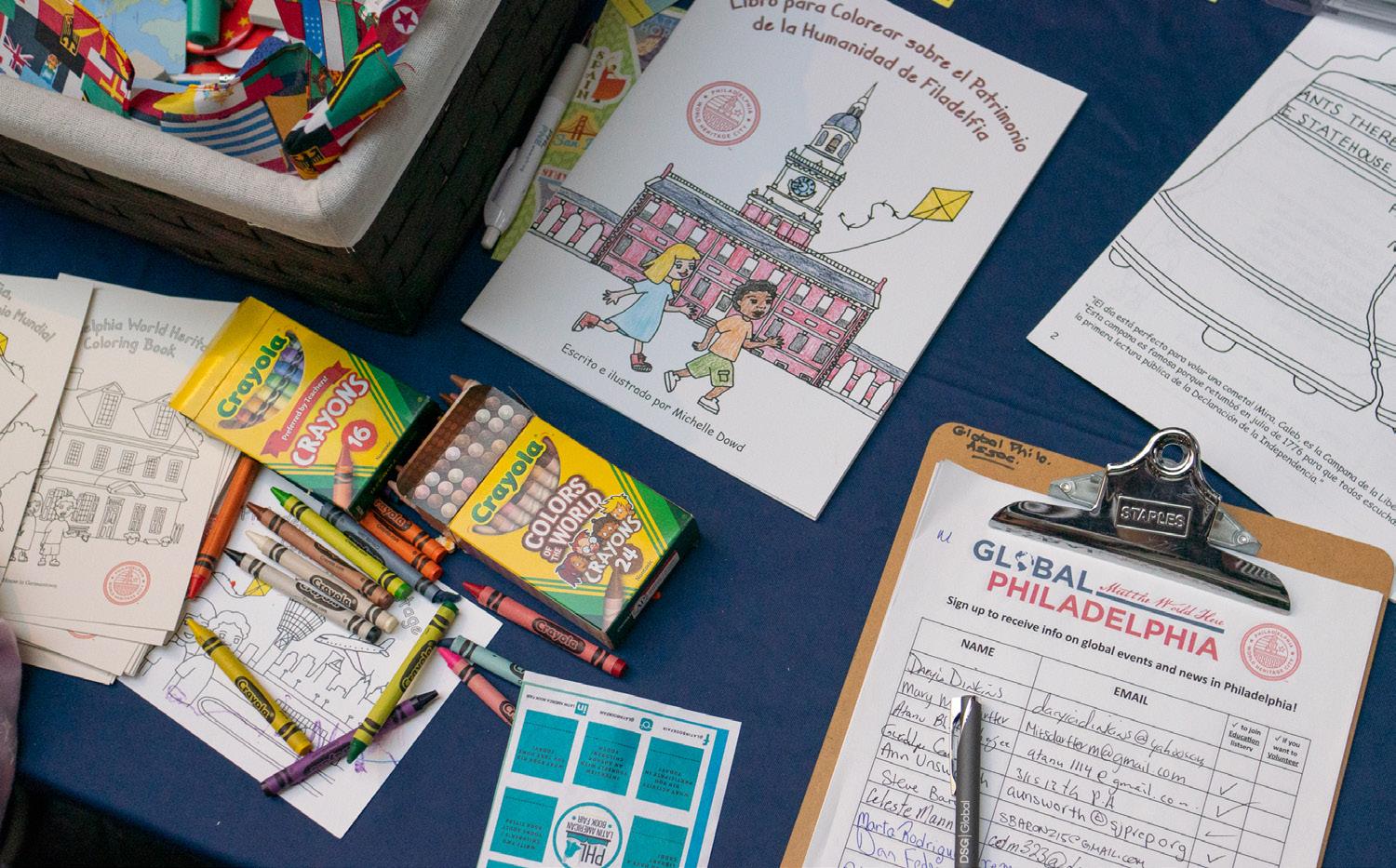
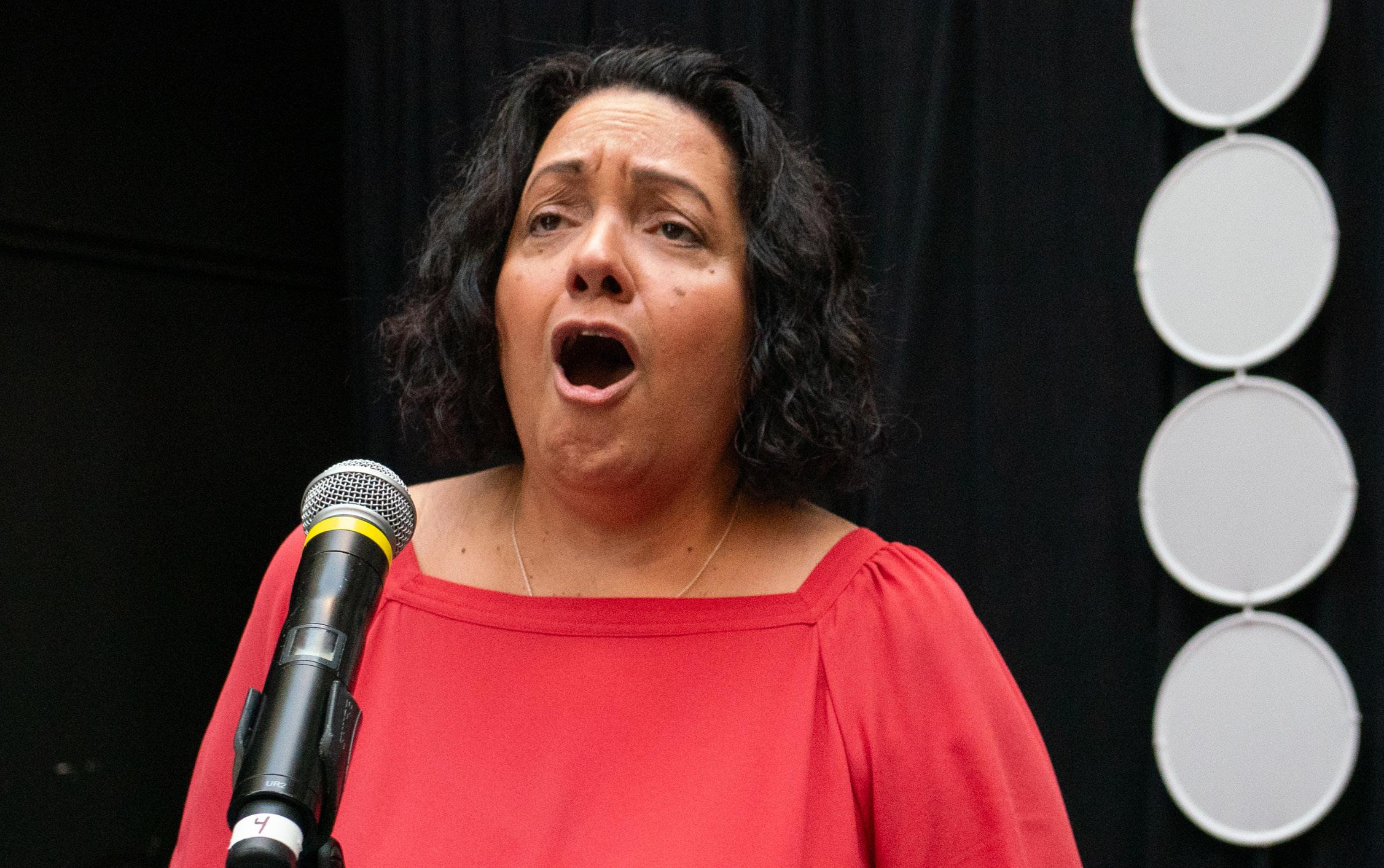



AIDAN GALLO / THE TEMPLE NEWS
The Global Philadelphia table at the 7th Annual Latin American Book Fair.
BRIAN NELSON / THE TEMPLE NEWS
Internationally published author Clara Elena Garcia and her stand.
AIDAN GALLO / THE TEMPLE NEWS
Ada S. Ortiz, author of “Gabby’s Adventures,” shows one of her favorite images from her children’s book.
BRIAN NELSON / THE TEMPLE NEWS
Author Marta Sanchez talks with a book fair attendee.
AIDAN GALLO / THE TEMPLE NEWS
Evelyn Santiago Schulz, a vocalist for The Philadelphia Orchestra, sings at the book fair.
Students, avoid overloading your work schedule
BY WANIA IRFAN & CAELAN O’NEILL For The Temple News
Students are constantly trying to balance out their social and academic responsibilities, running on little sleep, downtime or reflection. They often trade exhaustion stories like trophies and treat a packed schedule as a badge of honor.
Students like Hemani Shankar often struggle to balance a busy schedule and free time and feel they have to sacrifice rest for productivity.
“I often feel pretty guilty for resting, it feels like only during breaks I can relax fully, but even then, I really feel like I should be preparing for something or doing something productive instead of just resting,” said Shankar, a junior neuroscience major.
It’s important to be a well-rounded student. However, people shouldn’t glamorize burnout; it doesn’t lead to student success but instead hinders it. Students who are unable to balance school and extracurriculars are not sluggish or disinterested, they are just trapped in a culture that glorifies overworking.
There are ways to reframe the toxic narrative around over productivity. Students should strive to reframe their mindset around productivity, as overworking can have detrimental side effects on their lives.
Hustle culture isn’t only disruptive, but it can also erode well-being and learning. Overcommitment and effort-reward imbalances contribute to burnout among college students, according to a July 2024 study by the Journal of Affective Disorders Reports.
Many students started to treat downtime as a guilty pleasure. Students sign up for everything, convinced they’ll fall behind if they don’t. However, when students’ calendars are stuffed, their performance often suffers. Burnout dulls focus, creativity and motivation. It also pushes students into isolation just when they need community most.

Exhaustion is the new norm in campus culture. Social media contributes to this glamorization; there are popular trends like “my 5-9 after my 9-5,” which showcases unrealistic standards of productivity and countless creators make videos about how to hack the system and get more done in a day. This type of content constantly reinforces the idea that overworking is the only way to succeed.
Jennifer Johnson, associate dean of student success, believes different factors, like the pandemic, have combined to encourage students to equate exhaustion with success.
“The motto of Temple University and the ways that we talk about Temple University students, ‘perseverance conquers,’ there’s this Philadelphia-ness of just grit and resilience and just working really hard,” Johnson said.
It’s understandable for students to want to engage in several extracurriculars, but burning themselves out now will only delay their success in the future. But students can use some of the time and energy they use overworking and put it into things that will help them
recharge like picking up new hobbies or simply relaxing for an hour.
Students don’t have to do get through this era of grinding alone. Professors can also aid them by being a resource for navigating coursework and learning time management skills, so students can learn to find a balance.
Jean Boyer, a teaching and learning professor, believes instructors can also help decrease the stressors students face.
“The responsibility that faculty has, as we teach our classes and engage our students, [is] say what are we doing to mitigate these stressors that students experience,” Boyer said.
Mental health of college students has declined. Temple responded to the mental health toll by hiring additional counselors and creating a new Health and Well-being division in 2023. The university’s counseling center saw more than 3,400 students in the 2021-22 school year and a 281% increase in crisis visits since the previous year, WHYY reported.
Thirty-six percent of students cite busy schedules as a reason they can’t join
clubs or on campus organizations. Most students meet their friends through these extracurricular activities, according to a February 2025 survey conducted by The Temple News.
It takes more than just advice to change the overworking culture, but students can start by saying no to draining plans, protecting sleep and scheduling time to relax and enjoy.
College is supposed to be about growth, not just grind. Productivity doesn’t determine success and it’s important for students to embrace balance and a shift in the hustle mindset.
wania.irfan@temple.edu caelan.oneill@temple.edu
Two students argue that busy schedules are not equivalent to success.
SOFIA LYDECKER / THE TEMPLE NEWS


ALL IN GOOD FUN



Northeastern Foliage Word Search
L
C
Plant Trivia Crossword
Plants Trivia

U
J U D M C C Q
K O R Y E C Z N X W R
S X O E I F F V S V S G A P L G E G G E
T U X E Y A U C H R Y S A N T H E M U M
A H H T F V F F E A T R U R G D M K A T
A T G G J E R E Q I P C W U K E H T X W
L T O U M X B M O P J H S J K R A K C E
I K L M S X T H W N X K L H U T B Q F M
T Y G N U E K I P Q D Z E P Z V V K J L
V J V K K J S U G A R M A P L E E R K K
Chrysanthemum Sugar Maple Hydrangea
Sassafras Sweet Gum Hawthorn
Dogwood Hickory Red Oak
Aspen Birch Sumac
Hosta
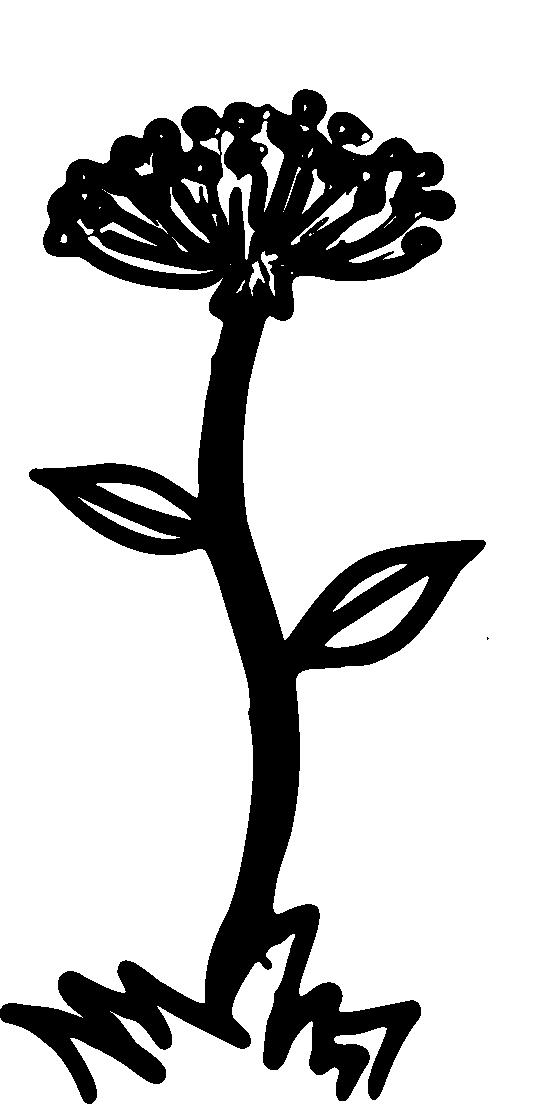
Across
4. The flower that knocked Dorothy out
Across 4. The flower that knocked Dorothy out 6. Song by The Goo Goo Dolls released in 1998 7. The fastest growing plant in the world 8. The only fruit to bear seeds on the outside 10. The cookies made by an elf in a tree 12. DC villain with the real name Dr. Pamela Isley
6. Song by The Goo Goo Dolls released in 1998
7. The fastest growing plant in the world
8. The only fruit to bear seeds on its outside
10. The cookies made in a tree by an elf
12. DC villain with the real name Dr. Pamela Isley
Down
Down
1. Marvel's extraterrestrial tree-like character
1. Marvel’s extraterrestrial tree-like character
2. Dr. Seuss' trees used to make Thneeds
2. Dr. Seuss’ trees used to make Thneeds
3. Carnivorous plant with a slippery pitfall to catch prey
5. Transferring light energy into chemical energy
3. Carnivorous plant with a slippery pitfall to catch prey
5. Transferring light energy into chemical energy
9. The *weeping* tree behind the owl statue on Main Campus
11. What Grant Ellis and Jenn Tran handed their suitors

9. The weeping tree behind the owl statue on Main Campus What Grant Ellis and Jenn Tran handed their suitors
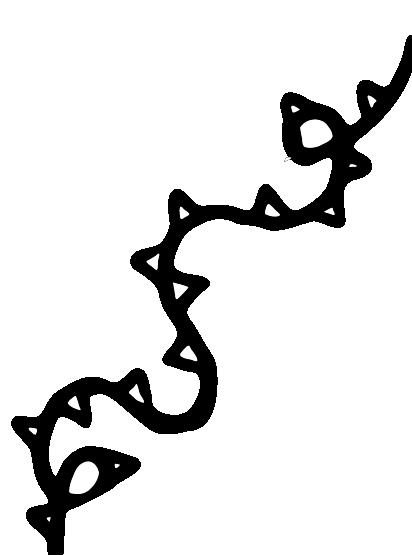
FEATURES
Owls and Dragons collide at Battle of the Bands
MUSIC Temple-representing bands faced off against Drexel’s championing groups.
BY REESE WEINGARTEN For The Temple News
On the night of Oct. 3, students from both sides of the Schuylkill River shuffled into the backyard of The Garden, a DIY music venue in North Philly, itching to cheer on their fellow Owls or Dragons in Deadbug Collective’s Drexel vs Temple Battle of the Bands.
Jude Kodama, a Drexel student and founding member of Deadbug, vividly remembers his first house show and wanted to recreate that magnetism.
“We were blown away by everything,” Kodama said. “The passion, the talent, the welcomeness of the whole scene. We’ve seen a divide between Temple and Drexel’s scenes, and we wanted to bridge that gap.”
Deadbug Collective is a student-run booking group based in West Philly, created by several Drexel students. The bands featured on Oct. 3 were Mount Cloud Collective and Cadalay for Temple, while Riot Diner and Cheap 52 represented Drexel. Each band performed 20- to 30-minute sets with hosts coming in during breaks to hype up the crowd.
After Mount Cloud Collective’s set, Kodama took to the mic stand to welcome the crowd. Instead of adding fuel to the rivalry, their speech was one of connection between the two schools.
“The beef between Temple and Drexel, it’s a rivalry,” Kodama said. “But I want everybody out here to feel the love and connection and the integrity of the scene.”
Kodama DJed between Mount Cloud Collective and Riot Diner’s sets to keep the audience entertained, incorporating their “deadbug” producer tag throughout. Fans could purchase homemade pins, t-shirts and stickers throughout the show, made directly by the artists.
Despite the intense rivalry, some

viewed the battle as a friendly competition. Emcee Jeb McCormick, a senior advertising major, said the event was inspired by the abundance of bands at each school.
“They’re both very creative schools that have great bands,” McCormick said. “It totally makes sense. It’s not really a competition, more of a bonding experience.”
The audience showed love for their universities by wearing their respective school’s merch and chanting their respective names. Jacob Piotrowski, a freshman neuroscience major, appreciated the local flavor that the event brought.
“I think what I like is the variety of bands that there are bands from all around Philly,” Piotrowski said. “I think this is a cool event that brings schools together.”
Despite the ongoing battle, Mount Cloud Collective member and junior audio and live entertainment major Tim McCloud warmly embraced his opponents.
“I know that all the other bands here are great tonight,” McCloud said. “Drexel’s killer! Cheap 52 and Riot Diner kick ass. But yeah, I love Temple, and I love North Philly.”
While Cheap 52 was setting up for the final set of the night, McCormick split the crowd by school and encouraged the rivals to hurl insults at the opposing school. Temple students yelled toward Drexel things like “High tuition!” and “No campus!” while Drexel students rebutted with “John Fry!”
McCormick then commanded the two crowds to run into each other and the student obliged. Bodies clashed like medieval war before melting together
into one unified mosh pit.
By the end of the last set, students began clearing out and the crowd thinned. The emcees approached the stage one last time to announce the measurement process and measure the cheers of each school. Measured through a decibel meter app, Drexel beat Temple by 9 decibels, with a score of 116 dbs.
Although Drexel went home with the win, the Temple-Drexel rivalry remains strong. McCormick felt the showcase of bands from both schools was the greatest achievement of the night.
“I think that Drexel kids are cool, Temple kids are cool, and that we both do cool creative stuff,” McCormick said.
reese.weingarten@temple.edu
COURTESY / NATE RANSOM
AROUND CAMPUS
TUPD’s new trainee brings puppy love to campus
Temple’s Department of Public Safety debuted their new therapy dog on campus, Barkley.
BY BEN DIPALMA Assistant Features Editor
Chris Willard trained officers and police dogs for high-pressure scenarios for 17 years. During her time in the force, she faced countless challenges and dealt with a variety of different personalities. Her most recent trainee is a little different than the others.
This time, Willard isn’t instructing the average officer or bomb-sniffing K-9, but a 4-month-old chocolate lab named Barkley, the department’s first “comfort dog.”
“I think even though she’s not completely trained yet, I’ve already seen the benefits of so many officers stopping by our office,” said Willard, director of tactical and professional development for Temple’s Department of Public Safety. “It’s great for them just to see her, to play with her, cuddle with her throughout the day.”
Barkley, who was named after Eagles running back Saquon Barkley, is currently in basic training with Willard, learning how to sit, stay and come when she’s called as part of her year-long basic courses. After the introductory courses, she’ll take her Good Citizen and Advanced Good Citizen classes, the final stretch of training Barkley will need to earn her comfort dog certification.
Part of Barkley’s training involves becoming accustomed to being on campus and around students. Often, Barkley can be seen around Montgomery Avenue, wagging her tail and flaunting a slice of Eddie’s pizza she found discarded in the bushes. Students passing by often stop to say “hello” and rub her belly.
Barkley’s main role will be different than the majority of K-9 dogs on police forces. Typically, police dogs are used for tracking suspects and missing persons, detecting drugs or explosives and for apprehension.
Barkley’s primary role with DPS, on the other hand, will be de-escalation and

emotional support. The goal of Barkley’s presence on the force is to relieve the stress officers feel on the job.
Natasha Rivera-Overton, a dispatcher for DPS, regularly deals with stressful situations when fielding emergency calls. Barkley is helpful for her during these times.
“She’s a breath of fresh air,” Rivera-Overton said. “It’s great walking through the hallways and getting to see her. She brings happiness and joy into the department.”
Barkley is the first therapy dog of her kind at Temple. However, her role is part of a growing trend nationwide of police forces training therapy dogs in several cities, including the Philadelphia Police Department.
The PPD introduced their “crisis-canine,” Bailey, in July 2025 to assist the department in high stress scenarios. Bailey, a golden retriever, was the first ser-
vice dog introduced to Philadelphia with the purpose of de-escalation and therapy.
Following the PPD’s lead, Temple introduced Barkley to the DPS. She joins the department’s two bomb-sniffing German Shepards, named Falco and Zaki. Falco has been with the force for two years, while Zaki was introduced just last year.
Willard has overseen all TUPD training for the past two years and worked with both other dogs, but now she spends time focusing on Barkley’s training.
Willard and Barkley go for at least two walks around campus a day. These strolls, however, usually get halted by students bombarding the pair to meet and pet Barkley.
“I’ve seen her like, three times now, and she is so cute,” said Rosie Eom, a junior health professions major. “Oh my goodness, I just love seeing her. She
makes me so happy, and I think she’s gotten a lot better at training too from when I first saw her like a month ago.”
While Barkley’s training continues, she’s already leaving a lasting impression on the DPS staff. The department hopes that her role in the force will lead to better morale for both students and officers.
“I think mental health and stress management is so important to our first responders that anything we can try or anything we can do to help them manage that is worth a try,” Willard said. “If it takes cuddling with a dog during the day, then so be it.”
ben.dipalma@temple.edu
JUSTIN ALEX / THE TEMPLE NEWS
Trainer Chris Willard stands with Barkley, the first TUPD comfort dog.
FEATURES
AROUND CAMPUS
“Cherry On Thursdays” garners mixed response
Students weighed in on Student Leadership and Engagement’s new school spirit initiative.
BY MADELYNNE FERRO, LEILA KASBARI & ERIN BAMFORD For The Temple News
Delaney Carr has never felt strong school spirit on Temple’s campus, so no surprise the sophomore marketing major disregarded the “Cherry On Thursdays” promotions in the bookstore and Independence Blue Cross Student Recreation Center.
The one time she wore red on Thursday, it was an accident.
“I kind of noticed that more people were wearing red,” Carr said. “Then I thought about it and I’m like, ‘Oh yeah, today’s that day.’”
Carr’s laissez-faire attitude toward school pride is one of many reasons the Cherry Working Group — led by Student Leadership and Engagement — encourages Temple community members to participate in “Cherry On Thursdays.” The program aims to motivate students, faculty, alumni and staff to display school
O I C E S


pride by wearing Temple gear on Thursdays.
SLE implemented the initiative on Aug. 28 and regularly meets to identify ways of promoting Temple spirit around campus.
The Thursday initiative has historically been on Fridays, coinciding with university pep rallies. But new data from the registrar’s office found that more students are on campus on Thursday than Friday, prompting the switch from “Cherry On Fridays” to “Cherry On Thursdays.”
“We thought it might be meaningful for it to move today a where more folks are actually here,” said Barbara Perlman, senior director of SLE.
But the greater campus attendance on Thursdays has fallen short since many students are unaware or apathetic to the change. Angela Cirelli, a senior public health major, recalled the Cherry on Fridays initiative her freshman year but had never heard of Cherry On Thursdays.
“I haven’t noticed particularly any extra red on Thursdays,” Cirelli said.
Perlman is working with partners across campus to strengthen the initiative through other initiatives like a
Cherry On section in the bookstore and Cherry On themes in the dining hall.
Laila Little, a freshman musical theater major, knew “absolutely nothing” about the Cherry On Thursdays plan. However, she believes that most Temple students show school pride and have good energy.
After hearing the details of the initiative, Little was receptive to participating, but noted she would be more likely to participate if it was Cherry On Fridays.
“Hell yeah, I’ll participate in the future,” Little said. “Friday might be cool. Everyone’s happier on the weekends.”
Elyse Harvey, a junior media studies and production major, saw school spirit decline the longer she was at Temple. As a freshman, she regularly attended football games but slowly stopped going because, as she put it, “we suck.”
“Our sports programs are not good and they’re even less popular because we’re a city school,” Harvey said.
Some students are aware of the strategy. Taalia Ali, a freshman biochemistry major, had heard of the initiative and felt it was a logical move.
Ali firmly believes school spirit is
HOW DO YOU SHOW YOUR TEMPLE PRIDE?
Junior music technology major | they/them
“ By helping the clubs that I care about and tabling for events in the community. ”

Junior political science major | she/her
“ Wearing cherry and white on gamedays, being involved in activities, and showing up for class!”

important and present on campus, stating it was a factor in her decision to attend Temple.
“When I was touring other colleges and trying to decide which one I should go to, the students at other colleges were less engaged and dissociated,” Ali said.
Perlman measures school spirit by sporting and community event attendance — there is no current goal to gauge the success of Cherry On Thursdays.
“Our goal for the first semester was really to increase awareness,” Perlman said. “Just to get the community aware that this program is happening and that they can participate.”
Ben DiPalma contributed reporting.
madelynne.ferro@temple.edu leila.kasbari@temple.edu erin.bamford@temple.edu
Freshman mechanical engineering major | he/him
“ By exhibiting the values Temple embodies; perseverance is a big one, getting back up when knocked down. ”
Junior public health major | he/him
“ Wearing Temple apparel, supporting my friends in clubs and on the sports teams, and showing face at different events. ”
SOPHIA ROMICK
JOHANN CANO-SAGARDI
GRADY BACHMAN
RILEY HALL
VOLLEYBALL
SPORTS Temple feels conference struggles won’t continue
Temple is currently 1-3 in conference play but doesn’t expect to falter like last season.
BY AUSTIN BOYNES Volleyball Beat Reporter
Temple started the conference slate with a win against Rice on Sept. 26 but haven’t picked up a win in the three matches since. The Owls have struggled with starting strong out of the gate and are following the same downhill path they did last season, when they began conference play 1-4.
This has been a recurring theme the past three seasons for Temple. The team shoots out to a hot start in nonconference play before stumbling when American Conference action rolls around. When the dust settles, Temple then finishes the season with a losing record and the cycle repeats the following year.
This is head coach Linda Hampton-Keith and her staff’s fourth year at Temple. This also marks the first season where there are no players from former head coach Bakeer Ganesharatnam’s old roster. There is the opportunity to shake off the struggles, as Temple has an 11-7 record with a month left to play.
“They signed up for the things that we said we were out to accomplish and how they fit into that puzzle,” Hampton-Keith said. “So, I think it’s clearer now what it is we’re trying to do and their role in that, how they are going to contribute to the success of the program moving forward.”
Hampton-Keith values veterans on the roster, as she feels it is like having another coach on the court. Outside hitter Qairo Bentley is one of Hampton-Keith’s most experienced players, competing in her seventh collegiate season but playing for the first time since 2022.
Bentley has been a key voice on the court while aiding the defense. Outside hitter Leia Harper transferred in this offseason from Georgia Tech and has stepped up as a leader, both on and off the court. She leads the team in kills and digs to spark the Owls’ 10-4 start.
The squad welcomed eight freshmen

this season and some of them immediately started contributing to the team.
Libero Claudia Rivera and setter Daniella Gonzalez Murati headline the freshmen class. The duo represented Puerto Rico’s U19 National Team this summer, helping them perform at a high-level during their first collegiate season.
Rivera started the year playing libero alongside Maddie Metcalf, before taking the role for herself. She is second on the team in digs with 166 and crucial in keeping sets alive. Murati has been just as impactful with the second most assists on the team with 295, only trailing her setting counterpart, Lexi Yoza.
“This year we’re a younger team with lots of grit,” Yoza said. “We’ve been fighting through a lot of really tough games and coming out on top and coming from behind, we’re just really fighters this year.”
The nonconference schedule featured 10 away matches with the hopes of eliminating the team’s road woes that
have caused the Owls issues. Temple won just two road matches and started 0-5 away from McGonigle Hall against conference opponents last season.
The Owls went 5-2 on their opponent’s court to start the season before playing their first two conference matches on the road. The Rice match gave Temple a road conference win, but it was promptly swept two days later by Tulane on Sept. 28 in New Orleans.
“Going on the road in our conference is really hard, so getting a split weekend, our first weekend, really happy with that,” said outside hitter Olivia Hummel. “We just try and do the best we can to limit what we have to do on the road so if that’s trying to get your work done before, try to watch all the practice film before we need to go.”
Hampton-Keith understands that to reach the postseason they need to be able to hold each other accountable. She has helped the team get comfortable with those difficult discussions by dedicating
time at the end of practice for “shout outs and call ups,” where the team gives compliments and criticisms.
Hampton-Keith uses “call up” so that instead of blaming their teammates, they can help them reach the standard that has been set. This reframes those tough conversations and turns them into constructive criticism.
Despite the recent slide, Hampton-Keith remains confident in her team, describing them as the most “bought in” squad that she has had at Temple. With just 13 matches remaining on the schedule, it is up to them to play up to the talent that they have shown.
“Collectively, we’re just so much more centered on our mission and we’re not gonna let some things deter that,” Hampton-Keith said. “It’s been fun to watch us and to watch us fight the way we have.”
austin.boynes@temple.edu @austin_boynes
LILLIAN PRIETO / THE TEMPLE NEWS
Temple Volleyball celebrates after setter Daniella Gonzalez Murati gets a kill against South Florida on Oct. 3.
CREW
Owls look inward for first step to championship
Temple is focused on rebuilding its chemistry as it strives for the IRA National Championship.
BY JACOB MORENO Assistant Sports Editor
Temple’s first step to prepare for the fall season took place on the water, it just didn’t have anything to do with a boat.
When the team returned from summer break, they took a 20-minute trip to Wissahickon on a sunny Saturday for an unofficial team bonding day. The team brought in 13 freshmen and the upperclassmen wanted to build team chemistry before the season started.
They spent the day swinging on rope swings, wandering around and snapping photos to make sure the memory lasts. That day of relaxation helped guide Temple during the fall season, which began in the Head of Ohio race on Oct. 4.
Temple was coming off one of its most successful seasons this summer. It picked up its first Dad Vail Regatta win since 2021, qualifying for the IRA National Championships in the process. The accolades didn’t stop there, as the Owls traveled across the pond for the Henley Royal Regetta on July 2 in Henley-on-Thames, England.
“What we’re looking for from last year was that [the players] saw that it can be done,” said head coach Brendan Cunningham. “They’ve just taken that confidence in knowing that the work that we’re doing does pay off and is what we need to do. You can’t rely on last year’s results to push towards this year.”
Temple’s success last season began after a disappointing fall campaign. The team went the entire fall without a single first place finish, a lackluster start to Cunningham’s second season as coach. However, the Owls experienced a mental reset after talking with Michael Moore, a Temple Crew alum and Olympian in the 1992 Summer Olympics, during their spring break.
Temple caught fire after the discussion, and its Varsity 8 and Second Varsity 8 boats finished in first place in the Bergen Cup Regatta on April 26. The momentum bled into Dad Vail Regat-
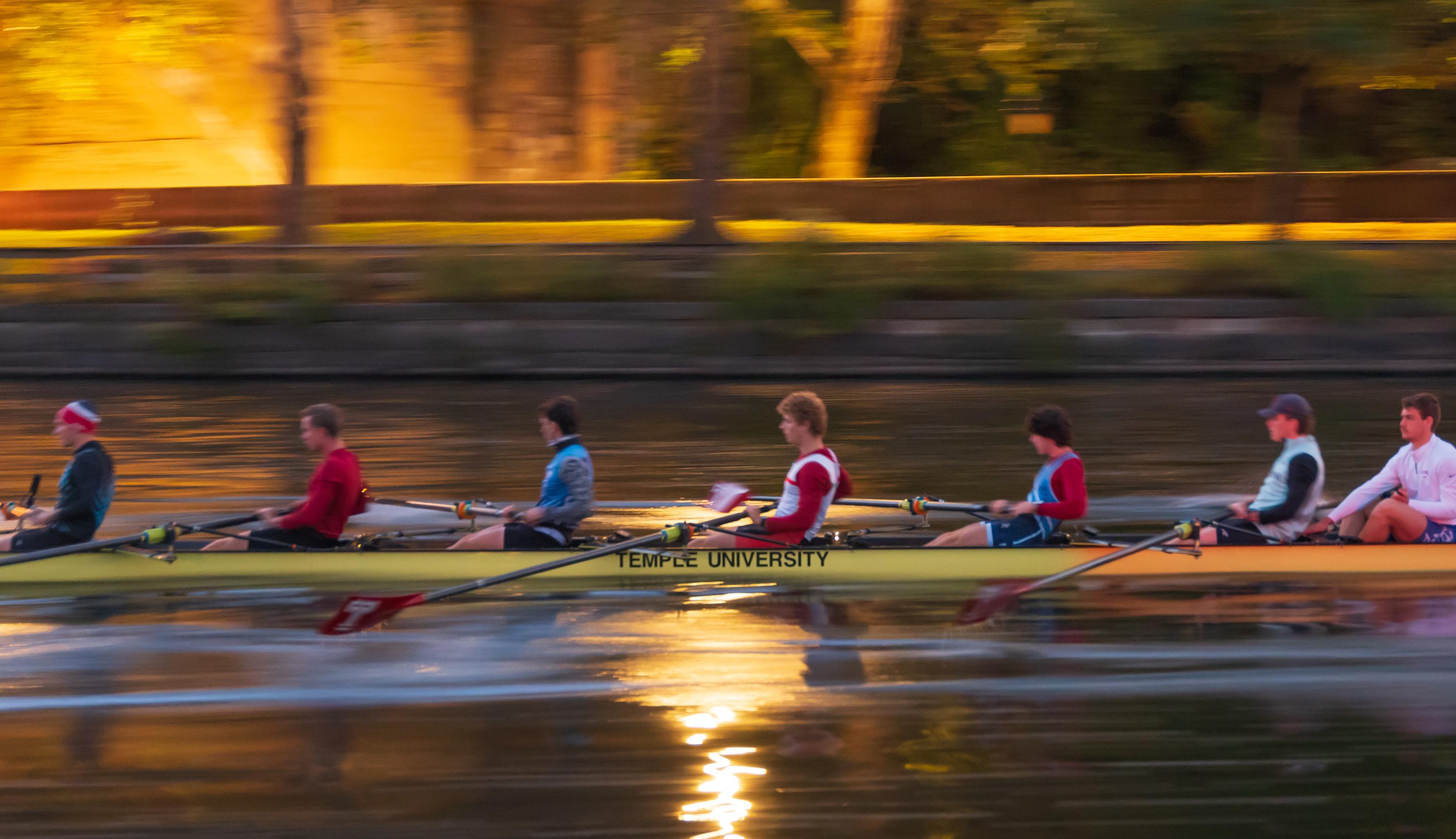
ta on May 10. Three of Temple’s boats notched first-place finishes, including its Varsity 8 boat, which earned the Richard O’Brien-James Hanna Trophy for the first time since 2021.
The turnaround earned them the 2024-25 Comeback Team of the Year by The Intercollegiate Rowing Coaches Association.
“In a regatta where you’re racing against the top Ivy Leagues, [winning Comeback Team of the Year] was quite the precedent that we set,” said rower Sebastian Rawson. “Obviously we can’t win Comeback Team of the Year anymore, since we’re kind of known now. But, there’s higher goals that we can try to shoot for.”
Those fall blunders will have to be remedied in 2025 if Temple wants to achieve similar success. This is something the team is actively working on by having consistent working as a team and striving for greatness every time they hit the water.
The Owls began the 2023 season
slow during Cunningham’s first year as head coach and the same happened last year. However, Temple already progressed with two first place finishes this weekend.
Rawson was one of the team’s captains last seasons and will lead the team alongside Konstantin Kluge. The pair are in charge of getting the 13 freshmen up to speed before the spring season kicks off. Following its trip to Pittsburgh this past weekend the team will stay in Philadelphia for the Navy Day Regatta on Oct. 12 before traveling to Boston for the Head of the Charles Regatta.
“When I saw the new freshman this year, I was very interested,” Kluge said. “They were very motivated [saying], ‘Oh, we’re finally on the college team.’ It’s like, now it’s not college anymore. It’s more like competing against bigger crews and the next chapter.”
With four more races remaining before the fall season ends, Cunningham expects the team to give their best each day. Temple has projected upward each
season under him and is expected to follow the trend in 2025.
The Owls have the same feeling as Cunningham and their team-first mentality will motivate every boat that hits the water. At the end of the day, the goal is to win and the team feels like they are in the best position to have a successful season, Rawson said.
“When you’re in the boat, you all have one mission. That is to win and to compete and to be the best that you can,” Rawson said. “You kind of have to put everything aside and just be united. It’s not always easy. There’s always going to be some type of agitation, some type of struggle, but I think that’s what kind of makes rowing so beautiful and makes any team sport so great.”
jacob.moreno0001@temple.edu @jmoreno76ers
COLT GUNN / THE TEMPLE NEWS Temple Men’s Crew rows along the Schuylkill River on Oct. 2.
Owls’ first test shows depth can be the difference
FOOTBALL Temple passed its first real trial of the season against UTSA by using its improved depth.
BY COLIN SCHOFIELD Co-Sports Editor
For the last four years, Temple has been defined by a number: three. The Owls have recorded only three wins for the last four seasons, stuck in a loop of inferior football. It took a month for the reinvented Owls to prove they are a completely different team under new head coach K.C. Keeler.
It was nearly impossible to judge the Owls by their first four games. They played against UMass, a team that is currently 0-5 and Howard, which plays at an FCS level. They were games Temple was supposed to win, so the blowouts were nothing to get excited about.
Then the Owls faced two nationally ranked teams that had losses chalked up before the opening kickoff. They went into their bye week with a 2-2 record which held basically no weight and gave away nothing to where the team actually stood.
Temple’s game against UTSA was its first real test, which it passed with a 27-21 win, despite struggling in the first half. The Owls have now matched their win total from the last four years and found their best start since 2019, showing the team can actually compete in the American Conference.
“When you saw the second half, that was Temple football,” Keeler said. “Not that I didn’t care if we won or lost, because you profit a lot more from your wisdom if you win. But I just wanted those guys to go out and battle.”
Temple trailed UTSA by 11 points at halftime — not an insurmountable deficit, but for the 2021-24 Owls, that halftime score nearly guaranteed a loss. Temple only had one game in the last four seasons where it completed a double-digit halftime comeback, against Akron on Sept. 2, 2023. When the team went into the locker room, the hope for the season was hanging by a thread.
Keeler told the players he was embarrassed to be their coach following

their first-half performance. His team was not playing “Temple football” and they had thrown all their hard work out of the window. But instead of collapsing, like they most certainly would have in the past, the Owls came back to the field stronger to prove their coach’s efforts weren’t in vain.
“It’s exactly what we needed to hear,” said quarterback Evan Simon. “I can’t say enough good things about Coach Keeler. Props to the leadership on this team who really stepped up and made some good plays, but it took way too long, so we’ll address that.”
Temple outscored UTSA 24-7 and outgained it by 93 yards in the second half, earning its first conference-opening win since 2021. The Owls had contributions from numerous unheralded players who showcased the striking difference in personnel from years past.
Last year, the offense hinged on wide receiver Dante Wright’s production. He led the team in receiving yards, with 468 more than wide receiver Ashton Allen,
the team’s second leading receiver, and receptions with 37. This year, Simon can pick his poison for who gets the ball and this was on full display against a UTSA pass defense, which ranks last in the American.
Tight end Peter Clarke led the Owls in yards with 82 on four catches and added a touchdown. Each of his catches provided relief for the team, including a 36-yard catch where he dragged multiple UTSA defenders on their first drive of the third quarter. This helped flip the game’s momentum in Temple’s favor. Clarke leads Temple in receiving yards, but he is not Simon’s only option like Wright was last year.
Wide receivers JoJo Bermudez, Colin Chase and Kajiya Hollawayne provided aid in the passing game and each continue to make proactive plays. Bermudez is fast and has great play ability; he scored Temple’s first touchdown. Chase had his best game of the season against UTSA with five catches for 43 yards and Hollawayne has been a reliable target for Si-
This game was the first true test the Owls faced and although it didn’t come easy to them, it showed how different the team is this year. Defensive injuries and a double-digit halftime deficit used to result in a blowout loss for the Owls, but this team managed to achieve a monumental win leading into the heart of conference play.
“We just beat a really good team, they’re a really good team,” said safety Jamere Jones. “They have a lot of really good players. And I think we just want to take that second half and carry it into the first half of the next game.”
colin.schofield@temple.edu @ColinSchofield9
mon when the team is in a bind.
LILLIAN PRIETO / THE TEMPLE NEWS Tight end Peter Clarke runs the ball to the endzone against UTSA on Oct. 4.
WELLNESS EXAMS BIRTH CONTROL ABORTION CARE GENDER AFFIRMING
CONTRACEPTION BIRTH CONTROL ABORTION CARE GENDER AFFIRMING
CONTRACEPTION SEX EDUCATION SEXUAL REPRODUCTIVE HEALTH
CONTROL ABORTION CARE GENDER AFFIRMING CARE EMERGENCY
ABORTION CARE GENDER AFFIRMING CARE EMERGENCY CONTRACEPTION
REPRODUCTIVE HEALTH WELLNESS EXAMS BIRTH CONTROL ABORTION
CARE EMERGENCY CONTRACEPTION BIRTH CONTROL ABORTION CARE
EMERGENCY CONTRACEPTION SEX EDUCATION SEXUAL REPRODUCTIVE
BIRTH CONTROL ABORTION CARE GENDER AFFIRMING CARE EMERGENCY
CONTROL ABORTION CARE GENDER AFFIRMING CARE EMERGENCY
SEXUAL REPRODUCTIVE HEALTH WELLNESS EXAMS BIRTH CONTROL
AFFIRMING CARE EMERGENCY CONTRACEPTION BIRTH CONTROL
AFFIRMING CARE EMERGENCY CONTRACEPTION SEX EDUCATION
WELLNESS EXAMS BIRTH CONTROL ABORTION CARE GENDER AFFIRMING
CONTRACEPTION BIRTH CONTROL ABORTION
